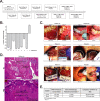A nanoengineered topical transmucosal cisplatin delivery system induces anti-tumor response in animal models and patients with oral cancer
- PMID: 35977936
- PMCID: PMC9385702
- DOI: 10.1038/s41467-022-31859-3
A nanoengineered topical transmucosal cisplatin delivery system induces anti-tumor response in animal models and patients with oral cancer
Erratum in
-
Author Correction: A nanoengineered topical transmucosal cisplatin delivery system induces anti-tumor response in animal models and patients with oral cancer.Nat Commun. 2022 Dec 21;13(1):7865. doi: 10.1038/s41467-022-35449-1. Nat Commun. 2022. PMID: 36543765 Free PMC article. No abstract available.
Abstract
Despite therapeutic advancements, oral cavity squamous cell carcinoma (OCSCC) remains a difficult disease to treat. Systemic platinum-based chemotherapy often leads to dose-limiting toxicity (DLT), affecting quality of life. PRV111 is a nanotechnology-based system for local delivery of cisplatin loaded chitosan particles, that penetrate tumor tissue and lymphatic channels while avoiding systemic circulation and toxicity. Here we evaluate PRV111 using animal models of oral cancer, followed by a clinical trial in patients with OCSCC. In vivo, PRV111 results in elevated cisplatin retention in tumors and negligible systemic levels, compared to the intravenous, intraperitoneal or intratumoral delivery. Furthermore, PRV111 produces robust anti-tumor responses in subcutaneous and orthotopic cancer models and results in complete regression of carcinogen-induced premalignant lesions. In a phase 1/2, open-label, single-arm trial (NCT03502148), primary endpoints of efficacy (≥30% tumor volume reduction) and safety (incidence of DLTs) of neoadjuvant PRV111 were reached, with 69% tumor reduction in ~7 days and over 87% response rate. Secondary endpoints (cisplatin biodistribution, loco-regional control, and technical success) were achieved. No DLTs or drug-related serious adverse events were reported. No locoregional recurrences were evident in 6 months. Integration of PRV111 with current standard of care may improve health outcomes and survival of patients with OCSCC.
© 2022. The Author(s).
Conflict of interest statement
M.G., A.M., A.B., B.L., P.C., S.C., B.F. and E.R.G. are affiliated with Privo Technologies. N.A. and S.G. serve as advisors for Privo Technologies. The remaining authors declare no competing interests.
Figures






Similar articles
-
A phase I study of cabazitaxel in combination with platinum and 5-fluorouracil (PF) in locally advanced squamous cell carcinoma of head and neck (LA-SCCHN).Oral Oncol. 2017 Aug;71:99-104. doi: 10.1016/j.oraloncology.2017.05.008. Epub 2017 Jun 16. Oral Oncol. 2017. PMID: 28688700 Clinical Trial.
-
Phase II clinical study of valproic acid plus cisplatin and cetuximab in recurrent and/or metastatic squamous cell carcinoma of Head and Neck-V-CHANCE trial.BMC Cancer. 2016 Nov 25;16(1):918. doi: 10.1186/s12885-016-2957-y. BMC Cancer. 2016. PMID: 27884140 Free PMC article. Clinical Trial.
-
Phase Ib study of duligotuzumab (MEHD7945A) plus cisplatin/5-fluorouracil or carboplatin/paclitaxel for first-line treatment of recurrent/metastatic squamous cell carcinoma of the head and neck.Cancer. 2016 Dec 15;122(24):3803-3811. doi: 10.1002/cncr.30256. Epub 2016 Aug 15. Cancer. 2016. PMID: 27525588 Clinical Trial.
-
Phase II/III Randomized Controlled Trial of Concomitant Hyperfractionated Radiotherapy plus Cetuximab (Anti-EGFR Antibody) or Chemotherapy in Locally Advanced Head and Neck Cancer.Gulf J Oncolog. 2019 May;1(30):6-12. Gulf J Oncolog. 2019. PMID: 31242976 Clinical Trial.
-
Phase 2 study of intratumoral cisplatin and epinephrine treatment for locally recurrent head and neck tumors.Ann Otol Rhinol Laryngol. 2004 Mar;113(3 Pt 1):229-33. doi: 10.1177/000348940411300312. Ann Otol Rhinol Laryngol. 2004. PMID: 15053208 Clinical Trial.
Cited by
-
Effects of artemisinin and cisplatin on the malignant progression of oral leukoplakia. In vitro and in vivo study.J Cancer Res Clin Oncol. 2024 Aug 18;150(8):390. doi: 10.1007/s00432-024-05924-x. J Cancer Res Clin Oncol. 2024. PMID: 39154308 Free PMC article.
-
Propranolol-Loaded Trehalosome as Antiproliferative Agent for Treating Skin Cancer: Optimization, Cytotoxicity, and In Silico Studies.Pharmaceutics. 2023 Jul 28;15(8):2033. doi: 10.3390/pharmaceutics15082033. Pharmaceutics. 2023. PMID: 37631247 Free PMC article.
-
MicroRNA expression as a prognostic biomarker of tongue squamous cell carcinoma (TSCC): a systematic review and meta-analysis.BMC Oral Health. 2024 Mar 31;24(1):406. doi: 10.1186/s12903-024-04182-0. BMC Oral Health. 2024. PMID: 38556858 Free PMC article.
-
Drug nanocrystals: Surface engineering and its applications in targeted delivery.iScience. 2024 Oct 16;27(11):111185. doi: 10.1016/j.isci.2024.111185. eCollection 2024 Nov 15. iScience. 2024. PMID: 39555405 Free PMC article. Review.
-
Advances in nanotechnology-based approaches for the treatment of head and neck squamous cell carcinoma.RSC Adv. 2024 Dec 9;14(52):38668-38688. doi: 10.1039/d4ra07193j. eCollection 2024 Dec 3. RSC Adv. 2024. PMID: 39654926 Free PMC article. Review.
References
-
- Howlader N, N. A. et al. (eds). SEER Cancer Statistics Review, 1975-2017, National Cancer Institute. Bethesda, MD, https://seer.cancer.gov/csr/1975_2017/, based on November 2019 SEER data submission, posted to the SEER web site, April 2020. (2020).
Publication types
MeSH terms
Substances
Associated data
Grants and funding
LinkOut - more resources
Full Text Sources
Medical

